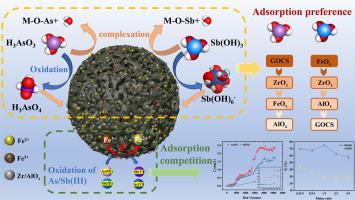Fe/Zr/AlOx-modified graphene oxide-chitosan aerogels for efficient removal of As(III) and Sb(III) from mining groundwater: Adsorption selectivity and mechanistic insights
IF 12.5
1区 化学
Q1 CHEMISTRY, APPLIED
引用次数: 0
Abstract
Arsenic (As) and antimony (Sb) contamination in groundwater poses serious threats to the environment and human health. In this study, graphene oxide–chitosan aerogel microspheres loaded with Fe/Zr/Al ternary oxides (IZA@GCAMs) were synthesized and systematically evaluated for their adsorption performance. IZA@GCAMs exhibited a high specific surface area (150–165 m2/g) and a hierarchical pore structure. Thermogravimetric analysis revealed that the incorporation of metal oxides enhanced structural stability and delayed thermal decomposition. Meanwhile, the amino and hydroxyl groups of chitosan not only provided initial binding sites for As(III) but also promoted the uniform dispersion of metal oxides and participated in subsequent complexation. The maximum adsorption capacities reached 248.51 mg/g for As(III) and 314.39 mg/g for Sb(III). Mechanistic studies indicated that As(III) first interacts with the functional groups of the chitosan matrix before binding to oxide sites, whereas Sb(III) directly forms stable complexes with Fe/Zr/AlOx, accompanied by partial oxidation, and in binary systems significantly suppresses As(III) removal by preferential site occupation. Density functional theory (DFT) calculations show that Sb(III) preferentially binds to FeOx, followed by ZrOx and AlOx, while As(III) tends to bind first to ZrOx, then to FeOx and AlOx. The material showed robust performance over pH 3–10 and high reusability, and efficiently reduced As/Sb in real groundwater. These findings elucidate the competitive adsorption mechanisms of As(III) and Sb(III) and demonstrate the practical application potential of this material in remediating As and Sb-contaminated groundwater.

Fe/Zr/ aloxs改性氧化石墨烯-壳聚糖气凝胶对采矿地下水中As(III)和Sb(III)的吸附选择性和机理研究
地下水中砷和锑的污染对环境和人类健康构成严重威胁。本研究合成了负载Fe/Zr/Al三元氧化物(IZA@GCAMs)的氧化石墨烯-壳聚糖气凝胶微球,并对其吸附性能进行了系统评价。IZA@GCAMs具有高比表面积(150 ~ 165 m2/g)和分层孔隙结构。热重分析表明,金属氧化物的加入增强了结构稳定性,延缓了热分解。同时,壳聚糖的氨基和羟基不仅为As(III)提供了初始结合位点,还促进了金属氧化物的均匀分散,参与了后续的络合作用。对As(III)和Sb(III)的最大吸附量分别为248.51 mg/g和314.39 mg/g。机理研究表明,As(III)首先与壳聚糖基体的官能团相互作用,然后结合到氧化位点,而Sb(III)直接与Fe/Zr/AlOx形成稳定的配合物,并伴有部分氧化,在二元体系中,As(III)通过优先占据位点显著抑制As(III)的去除。密度泛函理论(DFT)计算表明,Sb(III)优先与FeOx结合,其次是ZrOx和AlOx,而As(III)倾向于先与ZrOx结合,然后与FeOx和AlOx结合。该材料在pH值3 ~ 10范围内表现出良好的性能,具有较高的可重复使用性,并能有效地还原实际地下水中的As/Sb。这些发现阐明了As(III)和Sb(III)的竞争吸附机制,并展示了该材料在修复砷和锑污染地下水中的实际应用潜力。
本文章由计算机程序翻译,如有差异,请以英文原文为准。
求助全文
约1分钟内获得全文
求助全文
来源期刊

Carbohydrate Polymers
化学-高分子科学
CiteScore
22.40
自引率
8.00%
发文量
1286
审稿时长
47 days
期刊介绍:
Carbohydrate Polymers stands as a prominent journal in the glycoscience field, dedicated to exploring and harnessing the potential of polysaccharides with applications spanning bioenergy, bioplastics, biomaterials, biorefining, chemistry, drug delivery, food, health, nanotechnology, packaging, paper, pharmaceuticals, medicine, oil recovery, textiles, tissue engineering, wood, and various aspects of glycoscience.
The journal emphasizes the central role of well-characterized carbohydrate polymers, highlighting their significance as the primary focus rather than a peripheral topic. Each paper must prominently feature at least one named carbohydrate polymer, evident in both citation and title, with a commitment to innovative research that advances scientific knowledge.
 求助内容:
求助内容: 应助结果提醒方式:
应助结果提醒方式:


